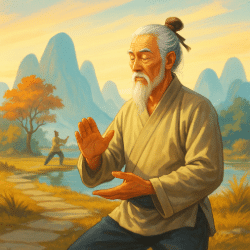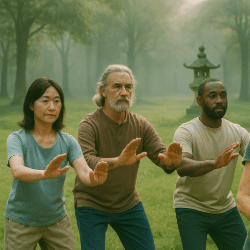Introduction
Qi (氣, pronounced “chee”) is the Chinese word for the energy that flows through all things and powers life itself. In modern times, the study and cultivation of this energy is called Qi Gong (also spelled qigong).
Within the 4 Ascendant Sphere Tradition, Qi is known as the Third Sphere, an entire dimension of Taoist practice. Over many centuries, Taoist schools and sects have developed thousands of unique systems of Qi Gong. But why was so much energy devoted to this work?
Below are five key forces that explain why Qi Gong arose and became such an important part of Taoist history and practice.
1. Qi Gong Has Shamanic Roots
In early Taoism, Qi Gong emerged from shamanistic dances that were believed to generate special powers or abilities.
Practitioners observed that certain gestures or movements during these dances produced energetic effects. Over time, these powerful movements were isolated and refined into systematic Qi Gong practices.
Early Qi Gong focused on three key goals:
Absorbing large amounts of Qi from the environment
Building the Shen (a stable internal structure for controlling Qi) to extreme levels
Generating strong, stable, external Qi fields
But these ancient practices weren’t without risk. They could create severe imbalances in health or even disturb the practitioner’s mind. For this reason, early shamanic teachers often chose students carefully, selecting only those most likely to survive and benefit from the intense training.
Historical note: The Zhuangzi (4th century BCE) includes stories of shamans dancing to control spirits and natural forces, while Han dynasty medical texts like the Huangdi Neijing describe “guiding and pulling” (daoyin) exercises that evolved into early Qi Gong methods.
2. Taoism Seeks to Unlock Full Human Potential
Another reason Qi Gong developed is Taoism’s core drive to maximize human potential.
Human capabilities depend on having enough Qi—just like a phone needs battery power to run all its apps.
Qi Gong exists because cultivating abundant, well-controlled Qi is seen as essential for realizing the full range of human abilities. Without energy, even the most talented mind or body cannot reach its peak.
Historical note: The Huangdi Neijing explicitly links health and longevity to balanced Qi flow, and the Liezi speaks of training the spirit and energy to transcend ordinary limitations.
3. Controlling Qi Is a Natural Human Capacity
Qi Gong is also based on the idea that humans are meant to control Qi within their bodies.
This isn’t considered a supernatural or forced act. Instead, it’s seen as a natural process—something as normal as developing muscular strength.
Just like building muscle, developing Qi control requires:
Repetition
Proper practice
Consistent support
Qi Gong was designed to help people cultivate this natural capacity deliberately and safely.
Historical note: Classical texts often describe Qi cultivation as returning to a childlike, natural state. The Dao De Jing encourages “embracing the One” and being like an uncarved block (pu), while Neidan (inner alchemy) traditions speak of “refining the Qi” like natural maturation.
4. Early Taoist Practice Was Not Always About Enlightenment
While many people today associate Taoism with enlightenment, that was not always the original goal.
In its early forms, Taoist practice—including Qi Gong—often aimed at:
Extending lifespan
Acquiring personal power
Gaining spiritual knowledge (Te, or 德)
Enlightenment was seen as something that arose naturally as a side effect of pursuing these goals, not necessarily the initial purpose.
Historical note: Texts like Baopuzi (by Ge Hong, ~4th century CE) detail methods of refining Qi to achieve longevity and supernatural powers, reflecting goals that predate or parallel the pursuit of enlightenment.
5. Enlightenment Requires Flowing, Abundant Qi
So why is Qi Gong now so strongly associated with enlightenment?
Because enlightenment is a high-energy state.
The Social Mind—the ordinary mindset shaped by culture and upbringing—is designed to operate at low energy. It even “bleeds off” Qi to stay stable and predictable. At higher energy states, the Social Mind becomes unstable.
True enlightenment involves thoughts, behaviors, and perceptions that aren’t possible with low energy.
Everyday Example: The “Aha” Moment
Think about a moment of sudden insight—an aha experience. You feel a brief shift in perception, a moment of clarity.
But why does it fade so quickly?
Because the Qi required to fuel that insight gets used up making the mental connection. As your Qi reserve diminishes, so does the effect of the insight.
Qi Gong exists to address this energy problem in two ways:
Lowering the energetic cost (by refining your mind and body to use Qi more efficiently)
Raising your energetic resources (by storing and cultivating more Qi)
Historical note: The Neiye (Inward Training), a Warring States text, already taught that mental clarity, virtue, and spiritual power arise naturally from cultivated Qi. Later Inner Alchemy texts formalized this connection by describing stages of energy refinement leading to awakening.
Conclusion
Qi Gong developed over thousands of years for both practical and spiritual reasons:
It grew out of shamanic roots, refining powerful movements for energy work.
It was driven by Taoism’s mission to unlock human potential.
It teaches natural human energy control.
It originally aimed at longevity, power, and knowledge—not just enlightenment.
It ultimately supports enlightenment by creating the high-energy conditions it requires.
In simple terms, Qi Gong is the art and science of making sure you have the energy you need to live, grow, and awaken.
Frequently Asked Questions
What is Qi?
Qi is the vital energy that powers life in Taoist philosophy. It's often described as breath, life force, or natural energy that circulates through all things, including the human body.
What is Qi Gong?
Qi Gong is the Taoist practice of cultivating, balancing, and controlling Qi through movement, breathing, and meditation. It has roots in ancient shamanic dances and evolved into structured systems over centuries.
Why did Taoists develop Qi Gong?
Taoists developed Qi Gong to absorb energy, strengthen the spirit (Shen), promote health, extend life, gain spiritual power, and ultimately support enlightenment by maintaining a high-energy state.
Is Qi Gong only for spiritual enlightenment?
No. Historically, Qi Gong also aimed at health, longevity, and personal power. Enlightenment became a later goal, supported by the energy cultivation that Qi Gong develops.
What classical texts support Qi concepts?
Classical sources include the Dao De Jing, Zhuangzi, Neiye (Inward Training), Huangdi Neijing, and Baopuzi. These works discuss Qi, health, longevity, and spiritual cultivation in varying detail.



